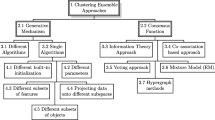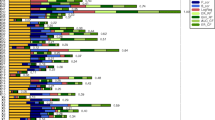Abstract
We propose a new classification ensemble method named Canonical Forest. The new method uses canonical linear discriminant analysis (CLDA) and bootstrapping to obtain accurate and diverse classifiers that constitute an ensemble. We note CLDA serves as a linear transformation tool rather than a dimension reduction tool. Since CLDA will find the transformed space that separates the classes farther in distribution, classifiers built on this space will be more accurate than those on the original space. To further facilitate the diversity of the classifiers in an ensemble, CLDA is applied only on a partial feature space for each bootstrapped data. To compare the performance of Canonical Forest and other widely used ensemble methods, we tested them on 29 real or artificial data sets. Canonical Forest performed significantly better in accuracy than other ensemble methods in most data sets. According to the investigation on the bias and variance decomposition, the success of Canonical Forest can be attributed to the variance reduction.



Similar content being viewed by others
References
Ahn H, Moon H, Fazzari MJ, Lim N, Chen JJ, Kodell RL (2007) Classification by ensembles from random partitions of high-dimensional data. Comput Stat Data Anal 51:6166–6179
Anthony M, Biggs N (1992) Computational learning theory. Cambridge University Press, Cambridge
Asuncion A, Newman DJ (2007) UCI machine learning repository. University of California, Irvine, School of Information and Computer Science. http://www.ics.uci.edu/~mlearn/MLRepository.html
Breiman L (1996) Bagging predictors. Mach Learn 24:123–140
Breiman L (1998) Arcing classifiers. Ann Stat 26:801–849
Breiman L (2001) Random Forest. Mach Learn 45:5–32
Breiman L, Friedman JH, Olshen RA, Stone CJ (1984) Classification and regression trees. Wadsworth, Belmont
Cohen J (1960) A coefficient of agreement for nominal scales. Educ Psychol Meas 20(1):37–46
Freund Y, Schapire R (1996) Experiments with a new boosting algorithm. In: Proceedings of the thirteenth international conference on machine learning. Morgan Kaufmann, San Francisco, pp 148–156
Freund Y, Schapire R (1997) A decision-theoretic generalization of online learning and an application to boosting. J Comput Syst Sci 55:119–139
Geman S, Bienenstock E, Doursat R (1992) Neural networks and the bias/variance dilemma. Neural Comput 4:1–48
Hastie T, Tibshirani R, Friedman J (2001) The elements of statistical learning: data mining, inference, and prediction. Springer, New York
Hayashi K (2012) A boosting method with asymmetric mislabeling probabilities which depend on covariates. Comput Stat 27:203–218
Heinz G, Peterson LJ, Johnson RW, Kerk CJ (2003) Exploring relationships in body dimensions. J Stat Educ 11. http://www.amstat.org/~publications/jse/v11n2/datasets.heinz.html
Holm S (1979) A simple sequentially rejective multiple test procedure. Scand J Stat 6:65–70
Hothorn T, Lausen B (2003) Double-Bagging: Combining classifiers by bootstrap aggregation. Pattern Recognit 36:1303–1309
Ji C, Ma S (1997) Combinations of weak classifiers. IEEE Trans Neural Netw 8(1):32–42
Kestler HA, Lausser L, Linder W, Palm G (2011) On the fusion of threshold classifiers for categorization and dimensionality reduction. Comput Stat 26:321–340
Kim H, Loh WY (2001) Classification trees with unbiased multiway splits. J Am Stat Assoc 96:589–604
Kim H, Loh WY (2003) Classification trees with bivariate linear discriminant node models. J Comput Graph Stat 12:512–530
Kim H, Kim H, Moon H, Ahn H (2011) A weight-adjusted voting algorithm for ensemble of classifiers. J Korean Stat Soc 40:437–449
Kohavi R, Wolpert DH (1996) Bias plus variance decomposition for zero-one loss functions. In: Proceedings of the thirteenth international conference on machine learning. Morgan Kaufmann, San Francisco, pp 275–283
Kong EB, Dietterich TG (1995) Error-correcting output coding corrects bias and variance. In: Proceedings of the twelfth international conference on machine learning. Morgan Kaufmann, San Francisco, pp 313–321
Kuncheva LI, Rodríguez JJ (2007) An experimental study on rotation forest ensembles. In: Haindl H, Kittler J, Roli F (eds) Multiple classifier systems. Springer, Berlin, pp 459–468
Kuncheva LI, Whitaker CJ (2003) Measures of diversity in classifier ensembles. Mach Learn 51:181–207
Leisch F, Dimitriadou E (2010) mlbench: machine learning benchmark problems. R package version 2.0-0
Loh WY (2010) Improving the precision of classification trees. Ann Appl Stat 4:1710–1737
Rodríguez JJ, Kuncheva LI, Alonso CJ (2006) Rotation forest: a new classifier ensemble method. IEEE Trans Pattern Anal Mach Intell 28(10):1619–1630
Schapire RE (1990) The strength of weak learnability. Mach Learn 5:197–227
Statlib (2010) Datasets archive. Carnegie Mellon University, Department of Statistics. http://lib.stat.cmu.edu
Terhune JM (1994) Geographical variation of harp seal underwater vocalisations. Can J Zool 72:892–897
Zhu J, Rosset S, Zou H, Hastie T (2009) Multi-class Adaboost. Stat Interface 2:349–360
Acknowledgments
Hyunjoong Kim’s work was partly supported by Basic Science Research program through the National Research Foundation of Korea (NRF) funded by the Ministry of Education, Science, and Technology (2012R1A1A2042177). Hongshik Ahn’s work was partially supported by the IT Consiliance Creative Project through the Ministry of Knowledge Economy, Republic of Korea.
Author information
Authors and Affiliations
Corresponding author
Appendices
Appendix 1: Pseudocode of CLDA
Given:
-
\(X\): the objects in the training data set (an \(n \times p\) matrix)
-
\(C\): number of classes
-
\(p\): number of variables
-
\(S_i\): covariance of class \(i\)
Procedure:
-
1.
Compute the class centroid matrix \(M_{C \mathbf{x} p}\), where the \((i,j)\) entry is the mean of class \(i\) for variable \(j\)
-
2.
Compute the common covariance matrix W:
$$\begin{aligned} W = \sum _{i=1}^C \left( n_i - 1\right) S_i \end{aligned}$$ -
3.
Compute \(M^*\) = \(MW^{-1/2}\) by using eigen-decomposition of \(W\)
-
4.
Obtain the between covariance matrix \(B^*\) by computing the covariance matrix of \(M^*\)
-
5.
Do the eigenvalue-decomposition of \(B^*\) such that \(B^* = VDV^T\)
-
6.
The columns \(v_i\) of \(V\) define the coordinates of the optimal subspaces
-
7.
Convert \(X\) to the coordinates in the new subspace:
$$\begin{aligned} Z_i = v_i^TW^{-1/2}X \end{aligned}$$ -
8.
\(Z_i\) is the \(i^{th}\) canonical coordinate
Appendix 2: Pseudocode of Canonical Forest
Input:
-
\(X\): training data composed of \(n\) instances (an \(n \times p\) matrix)
-
\(Y\): the labels of the training data (an \(n \times 1\) vector)
-
\(B\): number of classifiers in an ensemble
-
\(K\): number of subsets
-
\(w = (1,\ldots , C)\): set of class labels
Training Phase: For \(i = 1,\ldots , B\)
-
1.
Randomly split \(F\) (the feature set) into \(K\) subsets: \(F_{i,j}\) (for \(j = 1,\ldots , K\))
-
2.
For \(j = 1,\ldots , K\)
-
\(\diamond \) Let \(X_{i,j}\) be the data matrix that corresponds to the features in \(F_{i,j}\)
-
\(\diamond \) Draw a bootstrap sample \(X'_{i,j}\) (with sample size 75 % of the number of instances in \(X_{i,j}\)) from \(X_{i,j}\)
-
\(\diamond \) Apply CLDA on \(X'_{i,j}\) to obtain a coefficient matrix \(A_{i,j}\)
-
-
3.
Arrange \(A_{i,j}\) (\(j = 1 ,\ldots , K\)) into a block diagonal matrix \(R_i\)
-
4.
Construct the rotation matrix \(R^a_i\) by rearranging the rows of \(R_i\) so that they correspond to the original order of features in \(F\)
-
5.
Use (\(XR^a_i, Y\)) as the training data to build a classifier \(L_i\)
Test Phase: For a given instance \(x\), the predicted class label from classifier \(L\) is:
Rights and permissions
About this article
Cite this article
Chen, YC., Ha, H., Kim, H. et al. Canonical Forest. Comput Stat 29, 849–867 (2014). https://doi.org/10.1007/s00180-013-0466-x
Received:
Accepted:
Published:
Issue Date:
DOI: https://doi.org/10.1007/s00180-013-0466-x




